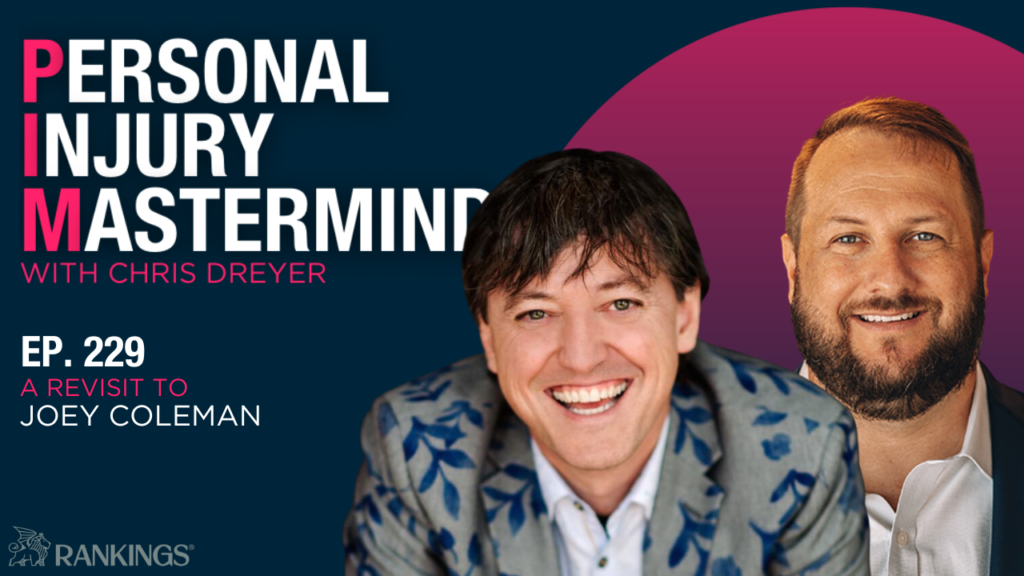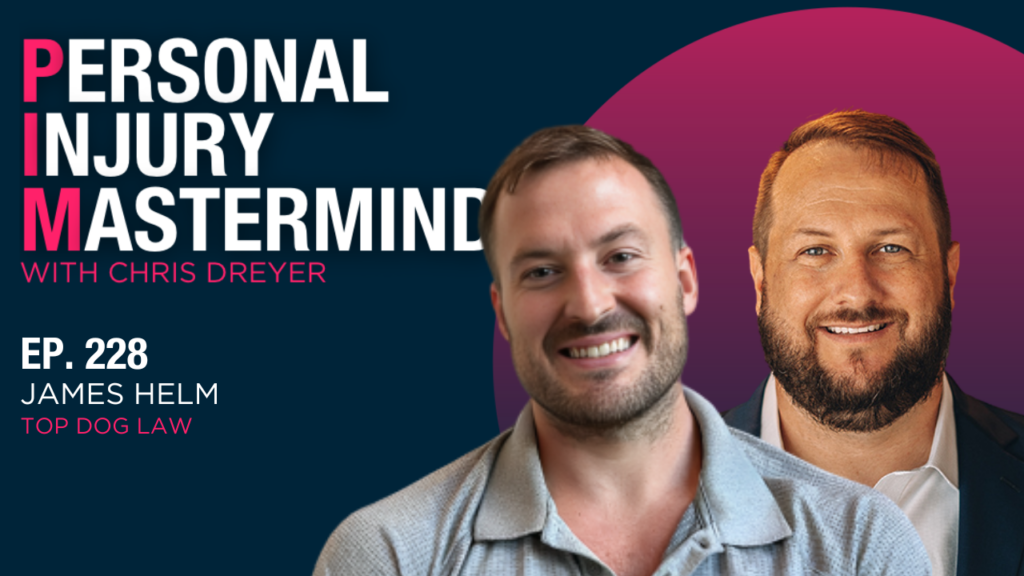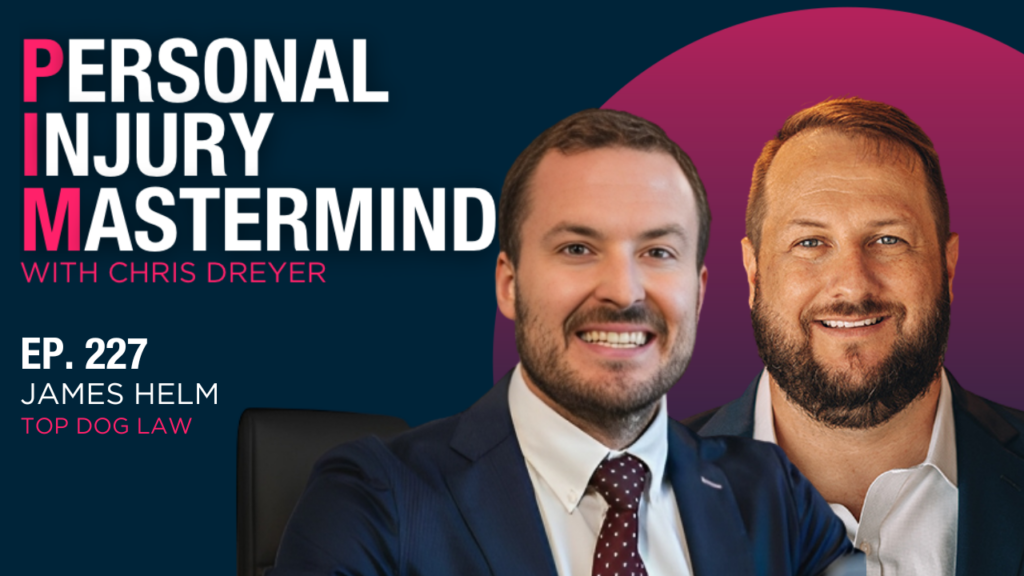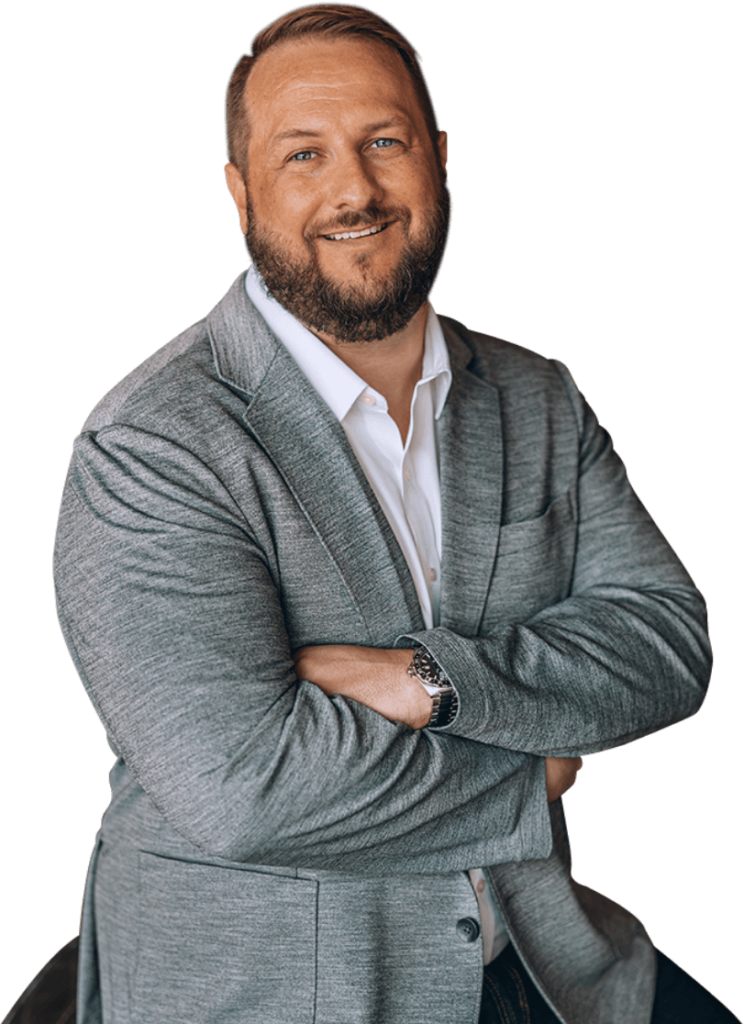Michael Blom:
Diversify your marketing strategy because you’re not going to get all of the different populations and lead types.
Chris Dreyer:
I have in the back of my mind Warren Buffett saying, “Diversification is a hedge against stupidity.”
Michael Blom:
For these clients, you don’t know how long it’s going to take or when the courts are going to reopen. That’s really the argument for the PI attorneys.
Chris Dreyer:
Welcome to Personal Injury Mastermind. I’m your host, Chris Dreyer, founder, and CEO of Rankings.io. The no excuses, no BS legal marketing agency that works harder in the competition. Each week you get insights and wisdom from some of the best in the industry. Before we get started, hit that follow button so that you never miss an episode. All right, let’s begin. The path to becoming a successful attorney rarely follows a straight line. There are twists and turns, pivots from one niche to another, unexpected obstacles. All of these can change and give away to new opportunities if you have the right perspective. Michael Blom has walked away with a winding path and came out on top. He created opportunities to serve both clients and other attorneys. He pivoted his personal injury practice to include mass torts. As the mass tort game changes, Michael’s here to help guide us through it.
New cases like L’Oreal and hair relaxers don’t start off as common knowledge. To earn the client, you need to educate the public. He shows us how it’s done. Just when Michael felt he settled into his new niche of mass torts, the events of 2020 caused another major ship. As the pandemic spread, Michael’s firm saw a chance to help businesses by diving into the world of employee retention tax credits. Today explains how your firm might be able to qualify for what is essentially free money. Over the years, Michael has proven that flexibility in seizing new opportunities and even uncertainty can lead to impacting success. Here’s Michael Blom, partner at The Lake Law Firm.
Michael Blom:
I’ve been barred for the past 10 years as a New York attorney and it really started at the end of my Penn State College career. My wife has always wanted to be a trial attorney. She was on mock trial in high school and also Penn State. I was pre-med at Penn State, so I was actually going to go a completely different direction. And then at the very end, I switched into psychology still to go to medical school and I was working at Johns Hopkins during the summer with my mom who works there at all different doctors and different research positions and just saw how busy the doctors were and the obligations that they had to have being a teaching university that they also had to teach. They really lived at the hospital.
It’s a great profession, but what I wanted to do was ophthalmology. It was another eight to 10 years of school and it wasn’t really for me at that point. So I thought of a switch, took the LSAT and went to law school the same time as my wife did. She does a very different line of work. I’m insurance defense, so she’s on the other side and I got into this whole mass torts business about a decade ago.
Chris Dreyer:
That’s interesting. The wife is on the other side, so do you come home, and you get to… I guess she’s the perfect person to run an argument to.
Michael Blom:
She is, and she’s better than me. I mean, she’s actually the true trial attorney. She’s done many trials, she’s great. So I’ve learned a lot from her over the years.
Chris Dreyer:
So take me a little bit your trajectory up to joining The Lake Law Firm and becoming partner for The Lake Law Firm. Tell me a little bit about that arc.
Michael Blom:
I started out of law school. I got a job working for defense firms, very large one, Sullivan & Cromwell, Urquhart Emanuel, Cravath, Swaine & Moore doing Dutch document review. These agencies really only knew me and my dad’s from Holland, so we lived over there. I speak fluent Dutch and this guy Hein, and he was in his 60s and they were being sued on all these different types of things, Philips Electronics, Royal Dutch Shell. So we would get calls, we have a million plus documents we have to review. They’re all in Dutch. No one knows how to translate them or read them, what’s privileged, what’s not, what are the hot docs. So they called me and this guy, Hein, pretty much name your price. And it was a ton of hours, 100 billable hours. So I was in 6:00 AM till midnight, seven days a week for many months. I did that for about a year and a half. It was great experience on the defense side, but it wasn’t something that was going to work.
I lived there, even asked if I could sleep at the firm overnight because I only got three hours sleep per night. So then I got a call for a mass tort position. It went over to Seeger Weiss, then went over to Levy Konigsberg for about seven years and handled all of their mass torts in their department. That was very interesting. That’s how I really got my mass tort experience, products liability, defective drug, medical device and product. And I’ve known Ed Lake for the past 10 years as well, going to Mass Tort Made Perfect, MTL, all different legal conferences. We worked with them at Gacovino and Lake at my last firm as well on some projects and decided to make the switch about two years ago. Been very busy ever since. So Ed runs at the speed of light. When he sees a new opportunity, we jump on it and that’s why we jumped on this employee retention tax credit opportunity last March. So it’s really half of our practice is tax credits, another half is mass torts at this point.
Chris Dreyer:
Yeah, fantastic. And I’ve had the pleasure of meeting Ed and yes, and through and through entrepreneur with his restaurant, with his multiple ventures. The first thing that I’m really intrigued about is, I guess twofold is first the capitalization side. And I’ve never really dug into this because with the single event, you’ve got cashflow coming in pretty consistently. So is it more the firm has to go through this maturity phase to have this vault of cash to jump into that area? Or do they partner with… And I don’t know much about them like an Esquire Bank or some type of funding company. How do you approach the capitalization side?
Michael Blom:
It really is. I mean, usually you’re having PI that’s funding the mass torts PI and MVA. Those are quicker turnarounds year, year and a half to be able to really invest in mass torts because these cases, they cost a lot to acquire. They’re between $1 to sometimes $10,000 plus per case to acquire, especially necrotizing enterocolitis baby formula cases and paraquat that they’re at the upper realm of that. It’s just they’re very difficult to get. There’s not that many cases. Some are easier to get. And then you’re waiting a very long time and with these bankruptcies that are going on with J&J and 3M and Aero Technologies, it’s really delayed even further. So when I started 10 years ago, they didn’t have those problems. They had resolutions to cases within two to three to four years large MDL settlements and all the claimants got paid and you could move on to the next mass tort project.
It’s really not like that anymore. So there’s mass torts that have been in the litigation phase for five, six and talcs going on eight, nine, 10 years at this point. They’re very long trajectories that it’s changed the way mass torts and mass torts attorneys are practicing and handling cases. So mass tort attorneys that I worked with 10 years ago, they’re actually doing PI and MVA now to bring in because they’ve spent so much money the past decade on advertising, bringing in the cases, the workup, filing all this filing fees, 350 apiece, all the litigation discovery, all the staffing that you have to have to do this type of work. And now they’re getting back into MVA and PI to fund their current practice and to keep going with their mass torts because you need resolutions on those. It’s really delayed a lot of things.
Chris Dreyer:
Yeah, it seems like with the awareness of Mass Torts Made Perfect and some of these big numbers that a lot more people have jumped in, there’s a lot more claimants, a lot more people trying to get that piece of the pie, raises the cost to acquire a case for risk mitigation. I have in the back of my mind Warren Buffett saying, “Diversification is a hedge against stupidity.” But we don’t know with torts like, look what happened to Zantac. Do you build a portfolio and that’s the approach? Do you go for Lejeune that’s got a fund or maybe AFFF that’s got the science? How do you approach the risk mitigation side of the torts?
Michael Blom:
You want to have a sizable portfolio, but across all the different mass torts. Because what we’re seeing in talcs being delayed, 3M’S being delayed with the bankruptcies, Camp Lejeune, they’re looking to reduce the attorney’s fees. Those court cases are actually very hard to prove as well because the records just aren’t there from the military records or even the diagnosing records. I mean, on top of that and then these newer ones where there’s really still developing here. Relaxers are brand new MDL, Tylenol with autism and ADHD, and there’s a couple other ones that may come up as well.
So it’s really to have the same amount of cases across what you’re able to handle. So you develop a budget and a portfolio, and that’s what we work with attorneys. We’ve seen what’s happened over the past 20 years and can really counsel them on which ones they get into maybe a higher number of… Hernia mesh, for instance. There’s a large manufacturer that’s looking to settle now that you can still get those cases and get a faster recovery versus hair relaxer that’s just starting out. And we can counsel on the injuries that we’re looking for, the ones to go after and the quantity of the cases as well.
Chris Dreyer:
The one thing you see someone like a linear going to be on Tylenol and that changes the game because of how good of a great trial attorney he is. And the other thing is the acquiring these cases, the strategies are so different depending upon the tort. Being an SEO guy, I look at hair relaxer and I look at the search opportunity and the phrases are all over the place for perms and L’Oreal. And unlike there just wasn’t a lot of volume. So I think some of these torts to capture them is a little… Capturing demand versus creating demand types of scenarios.
Michael Blom:
Yeah. And some attorneys, I mean, they’re doing very well on TikTok. Ben Crump, I believe he gets most of his mass tort leads from TikTok. He has a very large following and it works well for him versus other attorneys that do Facebook and Instagram. Some firms just like the traditional newsprints still or TV or radio. It really depends. And that’s also to diversify your marketing strategy, not to be all in on one type of media because you’re not going to get all of the different populations and lead types.
Chris Dreyer:
I see sites, for example, like Drugwatch. Is that like the Justia for… Do you pay for sponsorships and how does a sponsorship scenario work? Or is a firm owning that in the backend? Or is that just one big play from these companies that sell the cases and they’re using that as an asset?
Michael Blom:
I believe one or two firms have taken that over. It might be Simmons Hanly Conroy with Jane Conroy. I believe they’re one of the main sponsors or contributors. It’s a great site. I’ve gone to it many times over the year. It has a lot of information. They post a lot of the new litigations that they’re looking at. So it’s very well-developed, high SEO ranking
Chris Dreyer:
In 2020, the world changed, and businesses experienced unprecedented losses. Many kept employees, those who did may qualify for employee retention tax credits. There are a lot of misconceptions about who qualifies for this fund. So Michael is here to help break them all down.
Michael Blom:
So it’s a refundable tax credit through the IRS for business owners that kept their employees on during the pandemic. The relevant time period is March 2020 through September 2021. It’s six different quarters that you can qualify for, and a W-2 employee can be qualified for up to $26,000. So that’s the start. And then there’s a lot of different layers on how to qualify and who’s it for. There’s a lot of misconceptions about the program too.
So at first, if you took out PPP monies, you could not qualify for the ERTC, which came out in March of 2020 through the CARES Act. Now you can. So it’s just deducted dollar for dollar that you’re taking that out if you took out draw one or draw two. So what we’re seeing on average, overall now, we have a large dataset is about 12,500 per W-2 employee. If the employer took out both draws of PPP that you can still recover. And the IRS sends the business owner a check and they can use it for what they wish, it’s not a loan. It doesn’t need to be paid back. And there’s $50 billion put aside for this large project by Congress.
Chris Dreyer:
Drilling right into those specifics. First, let’s talk about the challenges. And I know many business owners work with a PEO, like an Insperity or there’s a ton of these. What does that business do? Do they have to go through Insperity? Do they go directly to you? Do they go to their PEO? How does that function when they have a secondary entity as a PEO?
Michael Blom:
Sure, we deal with that all the time. So a lot of these PEOs or even accountants, their own accountants either have not brought up ERTC at all to the business owner, that they just don’t know about it or they’ve looked at it and they think the business does not qualify. Or PEOs traditionally have looked at it and have seen maybe a quarter or two where there was a revenue decrease and have submitted the business for those one or two quarters for the ERTC and said, “Hey, we got this money back for you, business owner, one or two quarters. The other quarters we couldn’t claim, of course, because you had a revenue increase.” It’s really that they’re looking at the black and white numbers, the straight line revenue drop test.
So for 2020 to the same quarter in 2019, you had to have a 50% or more revenue drop. And then for 2021 you had to have a 20% or more revenue drop as compared to the same quarter in 2019. A lot of businesses had a revenue increase. So that’s where we come in. There’s a different way to qualify if the business was affected by local or state mandate in a more than nominal way, so more than 10% that it affected their total employee pool or 10% of their business operations. And you can tie that back. I can go through all different examples, but the most common ones are supply chain restrictions, either in your state that you’re operating or that you were affected by those in other states that affected your business. It could be that they limited the number of people in a room. For instance, New York I was working, I was completely shut down or the hours of operation that you couldn’t complete projects on time, time to do sanitation for COVID-19, that you were not able to complete projects that you could have.
But for the pandemic, these conferences, the legal conferences were completely shut down. I remember AJ went virtual, I believe it was in July of 2020, and it was very different. I mean, you were in a room on a laptop like I am now with avatars walking around talking to people, and you just don’t do business that way. It’s not the same as talking to someone face-to-face and shaking their hand. So you have a huge amount of reduced business and even if you had great business, you could have done even more, but for these restrictions that were in place. So that’s what it comes down to. And as attorneys, we’re able to craft these legal arguments, pull the governmental mandates, work with the business owners in really a 45-minute interview, how they were affected in each of the six quarters, and then detailing that in the legal memo. So it’s really audit ready before the IRS.
And we’re expecting between a 1% to 5% plus audit risk for the IRS. We haven’t had any ourselves, and that’s why we’re preparing these files like that. I also know that there’s some pending litigation going on. A lot of these PEOs and other entities, these companies that you see on TV, they may or may not have any tax attorneys on staff, any CPAs. A lot of the work is being shipped overseas calculation wise coming back and they’re just over submitting it to the IRS. The IRS then sends the business owner a check for what they believe they qualify for and it’s all overstated. So there’s actually litigation that’s going to start, that attorneys are going to be suing these ERC companies for overstating the qualifications because then the company gets a larger fee, of course, on the front end. And then the business owner is stuck with all of these overpayment that they have to send back to the IRS and all the penalties and interest.
Chris Dreyer:
Wow.
Michael Blom:
Yeah, it’s a serious thing that’s going on.
Chris Dreyer:
Yeah, and I heard too. I had the pleasure of speaking to Vinnie Fisher recently. He’s the owner of Fully Accountable, which specializes in financial services, and he was talking about your business typically has these five roles, and it could be multiple people, could be a few people. He is like, it’s a bookkeeper. You’ve got your CPA, you’ve got your controller, your director of finance, and then he led up to the tax strategist. And just like what you said, the CPA’s normally not going to bring this tax credit thing to you. It deviates from their standard processes. You got to go with someone like you. For the PI attorneys, for the PI law firm owners listening, because there wasn’t as many car accidents, not as many people driving to these sporting events, is that kind of thin because people weren’t going to these events? Or what kind of scenarios have you seen that the PI law firms could use as a case to file even if their potential revenue increase, let’s say?
Michael Blom:
I mean, my last law firm in New York, there was restrictions that you could only have so many people in a room. The number of hours that you could work during the day were reduced. And really the main thing for PI attorneys were the courts were shut down. So here in New Jersey, the courts… I mean, my wife wasn’t doing trials for two years. They just reopened a few months ago in New Jersey. So you can’t bring those cases. And then you’re having to settle at usually a much lower value because the defendant knows that you are not going to get the trial and knows it’s going to be prolonged out for years, and you still want to get a resolution for these clients. You don’t know how long it’s going to take or when the courts are going to reopen. That’s really the argument for the PI attorneys.
Chris Dreyer:
The court’s being closed. I mean, that’s the argument, right?
Michael Blom:
Yes.
Chris Dreyer:
That seems like a no-brainer. Let’s do a little improv. I’m a New York PI attorney. I was affected because the courts were shut down. I had 20, 30 employees and a decent amount of credit here. If I brought this to your firm today, what kind of process and what kind of timetable am I looking at before I would potentially, even if I was approved, see any type of check come in?
Michael Blom:
Sure. So I mean, we would do some initial qualifiers with what you just said. It would most likely pay us. So our minimum is at least three W-2 employees, that can’t include the business owner because that’s excluded through the IRS rules. Or any family members at the business, they’re also excluded. And then we would have our tax attorney speak with the business owner, the attorney, how they were affected in each of those six quarters, send them out a retainer agreement. It’s all in contingency, so they only pay after they get the check from the IRS. Then we invoice them. It ranges between 22% to 30%. So we give the larger businesses a break-down to 22% contingency fee. And that also includes complete audit protection within that as well. So if the business owner is audited, we defend them.
If it’s a desktop audit, we send in all of our calculations, represent them that way to get it cleared. And we also reduce our attorney’s fees pro rata, if they do need to send anything back, which we believe would not be the case if we’re handling those. We take a very conservative approach. And if it goes to a full audit that you have to go to court for, our tax attorneys do that as well at no charge. And then it’s really just collecting the documents after the business owner signs the retainer agreement, we send out a communication. So those are the 940 ones, the original ones, the payroll documents from 2019 to 2021. Profit loss statements to show if… We first look if there was a revenue reduction, it’s a quicker calculation and more concrete and easier to do than the governmental mandate.
So if there were a couple quarters that we can do that, we elect to do that way. And then we look for the governmental mandate side for the other quarters, which the PEO companies and most accountants do not do. They’re just doing straight line revenue drop tests. You might get a quarter or two paid out. And then once we get the other documents, if you took out PPP, those applications and then the quarterly payroll for the employees broken down in Excel. It’s really just talking to the controller or the CPA. They’re very willing to hand over those documents. They don’t want to handle ERC. You were right. I mean, they like doing tax preparation and those types of items, not this. So we actually get calls all the time from accounts say, “Can you handle my client’s ERTC claim? I’m too busy. I don’t know the regulations. Here you go.” So it’s referrals that way.
And then once we get all the documents, we run everything through a calculator. If it’s a revenue drop test and then also to calculate the credits on the governmental mandate side, fill out the 941-X, which is the amended 941 that would be filed with the IRS, send that to the business owner to review. They review everything, okay it, sign off at the bottom and send back. And then we send it to the IRS and we’re able to track the status as well through a POA form. So we know when they’re sending the check to the business owner and what the process is. And you’re typically looking at… It’s been a little bit delayed. So if you submit it tomorrow, for instance, the earliest would be about six months from tomorrow that you could receive a check from the IRS and it goes up to about 12 months right now. They’ve hired tens of thousands more agents for this project, for ERTC, the IRS.
Chris Dreyer:
Fantastic. Thank you for that explanation. And I would encourage you, if you’re a personal injury attorney, even if you didn’t experience a revenue decline, if the courts were shut down, which they were, definitely reach out, find out more information about this. It’s a fund. They have this set aside.
Michael Blom:
The statute of limitations on these, it will decrease. There’s two. So it’s three years from the date of filing from the original 941. So next April is the first, April 15, 2024, the $5,000 credit will expire, and then the entire program ends April 2025. Just for those listening, there is still some time on that. We hope that the program won’t be reduced. We don’t know what could happen. So we’re encouraging business owners to apply now and get the credit while it’s still there. And then you can, of course, use that money for your business now and to reinvest in it. It’s very important.
We also accept referrals. If there’s other attorney business owners out there, or even your own clients or leads that you can market to or former clients, there’s likely a large pool of business owners within the attorney’s files with all of their clients that they can refer to us. And we also have investment opportunities with high returns at this point that we’ve been running for several months. And the best way to get in touch with us is to just call 888-LAKE-LAW, our main line, and we have a landing page. It’s at ertcadvisors.org, and there’s a calculator at the bottom. There’s a lot of great information. We’re constantly keeping it updated with the regulations, FAQ section. Feel free to reach out to me, thelakelawfirm.com, you can go to. We have a whole page as well.
Chris Dreyer:
Thanks so much to Michael for sharing his wisdom. Let’s hit the takeaways. Time for the pinpoints. Be predictable. If you want to get into mass torts, build up a healthy and predictable personal injury case pipeline. This will help cover short- and medium-term expenses. Mass torts are expensive and can take up to a decade to resolve.
Michael Blom:
Usually, you’re having PI that’s funding the mass torts, PI and MVA. Those are quicker turnarounds year, year and a half to be able to really invest in mass torts because these cases, they cost a lot to acquire. They’re between $1 to sometimes $10,000 plus per case to acquire.
Chris Dreyer:
Create demand. For newer mass torts, the public needs to be educated about those cases. Diversify your channels to get the most exposure. Blend traditional with digital marketing to cast a wide net. Move into newer apps like TikTok to discover new markets.
Michael Blom:
Diversify your marketing strategy, not to be all in on one type of media because you’re not going to get all of the different populations and lead types.
Chris Dreyer:
Don’t leave money on the table. If you owned a firm between March of 2020 and September of 2021 and had three or more W-2 employees who are not family, it might be worth giving someone like Michael a call. The refundable tax credits will expire. So tap into the fund while you can.
Michael Blom:
It’s six different quarters that you can qualify for. So what we’re seeing on average is about 12,500 per W-2 employee. If the employer took out both draws of PPP that you can still recover.
Chris Dreyer:
For more information about Michael, check out the show notes. While you’re there, please hit that follow button so that you never miss an episode of Personal Injury Mastermind with me, Chris Dreyer, founder, and CEO of Rankings.io. All right everybody, thanks for hanging out. See you next time. I’m out.


























